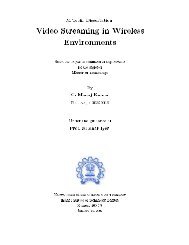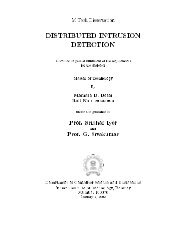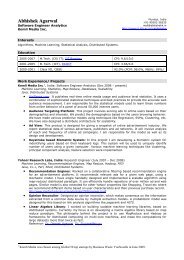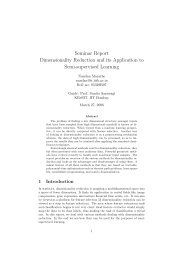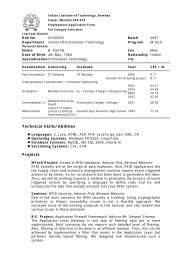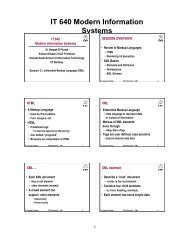A Method to Construct Counterexamples for Greedy Algorithms
A Method to Construct Counterexamples for Greedy Algorithms
A Method to Construct Counterexamples for Greedy Algorithms
Create successful ePaper yourself
Turn your PDF publications into a flip-book with our unique Google optimized e-Paper software.
counterexample if every possible path of execution leads <strong>to</strong><br />
a wrong answer.<br />
Maximum Independent Set Problem<br />
A graph G consists of a set V of vertices and a set E of pairs<br />
of vertices called edges. For an edge e = (u, v), we say e is<br />
incident on vertex u and v; vertices u and v are also the<br />
endpoints of e. The pair of vertices in an edge is unordered<br />
so e = (u, v) is the same as e = (v, u). The degree of a vertex<br />
is the number of edges incident upon it.<br />
Problem. Let G = (V, E) be an graph. The maximum<br />
independent set problem (MIS) is <strong>to</strong> find the largest vertex<br />
set S ⊆ V such that no two vertices in S have an edge<br />
between them in E. See Fig. 1.<br />
e<br />
a<br />
d<br />
b<br />
Figure 1: In the graph shown, S = {a, c} is a maximum<br />
independent set.<br />
Consider the following greedy approach <strong>to</strong> solve the MIS<br />
problem:<br />
Algorithm. When a vertex is picked, we are prohibited<br />
from picking its neighbors. Since we want <strong>to</strong> pick as many<br />
vertices as possible, we start by picking vertices with low<br />
degree[7].<br />
Algorithm 2.1: MIS(G)<br />
Input: Graph G<br />
Output: An independent set S from graph G<br />
Initially the set S is empty.<br />
1 : Sort the vertices according <strong>to</strong> their degree.<br />
Let V s be the sorted sequence.<br />
2 : <strong>for</strong> each vertex v in V s<br />
if vertex v does not have a neighbor in S<br />
add vertex v <strong>to</strong> set S.<br />
3 : Report S as the answer<br />
Consider the input graph in Fig. 2: a cycle of length 6<br />
(C 6). The size of the maximum independent set in this<br />
graph is 3 (set {a, c, e} <strong>for</strong> example).<br />
a<br />
f<br />
b<br />
Figure 2: Cycle C 6 has 3 independent vertices.<br />
As all the degrees of vertices are same, the algorithm could<br />
sort them in any order. If V s = [a, b, c, d, e, f], the algorithm<br />
returns {a, c, e} as the maximum independent set. However,<br />
if V s = [a, d, f, e, b, c], the algorithm returns {a, d} as the<br />
maximum independent set (incorrectly). Hence the input<br />
graph C 6 is a plausible counterexample <strong>for</strong> the given greedy<br />
algorithm.<br />
In general, we can convert a plausible counterexample in<strong>to</strong><br />
a definitive counterexample with some modification. In the<br />
e<br />
c<br />
d<br />
c<br />
above example, we want the algorithm <strong>to</strong> pick vertices a and<br />
d be<strong>for</strong>e others. We can ensure that by adding the edges<br />
(b, e) and (c, f) as shown in Fig. 3.<br />
a<br />
f<br />
b<br />
e<br />
c<br />
d<br />
⇒<br />
Figure 3: Converting a plausible counterexample <strong>to</strong><br />
a definitive counterexample. The size of the MIS<br />
in the second graph is 3 ({a, c, e}), but the greedy<br />
algorithm 2.1 always returns a set of size 2 ({a, d}).<br />
Although a definitive counterexample is more desirable,<br />
providing a plausible counterexample is a legitimate way of<br />
disproving a greedy algorithm.<br />
3. WORKING OF THE ANCHOR METHOD<br />
Our objective is <strong>to</strong> construct a counterexample <strong>to</strong> a given<br />
greedy algorithm. The anchor method follows a basic principle<br />
of problem-solving: solve an easier problem first. Instead<br />
of constructing a greedy counterexample directly, we first<br />
construct a counterexample <strong>for</strong> the weak algorithm. We call<br />
this a weak counterexample. Recall that a weak algorithm is<br />
obtained from the greedy algorithm by replacing the greedy<br />
choice with an arbitrary choice. The assumption is that the<br />
weak counterexample gives insight in<strong>to</strong> the structure of the<br />
greedy counterexample. Our method consists of two steps:<br />
Step 1 Build an anchor Use the weak counterexample<br />
<strong>to</strong> obtain an anchor. The anchor is a skele<strong>to</strong>n that<br />
captures the essence of a possible greedy counterexample.<br />
It serves as a starting point <strong>for</strong> constructing a<br />
counterexample <strong>to</strong> the greedy algorithm.<br />
Step 2 Add an auxiliary structure Attach an auxiliary<br />
structure <strong>to</strong> the anchor <strong>to</strong> obtain a complete counterexample.<br />
The purpose of the auxiliary structure is<br />
<strong>to</strong> ensure that the greedy algorithm essentially mimics<br />
the weak algorithm (and hence fails in the same<br />
way). Auxiliary structures usually have ‘extreme’ or<br />
‘common’ structures.<br />
We apply the anchor method <strong>to</strong> construct a counterexample<br />
<strong>to</strong> Alg. 2.1 <strong>for</strong> the MIS problem. This algorithm picks the<br />
vertices in increasing order of degree, so the corresponding<br />
weak algorithm picks vertices in arbitrary order.<br />
3.1 Maximum Independent Set: An illustrative<br />
example<br />
Building an Anchor. Consider the weak algorithm that picks<br />
the vertices in arbitrary order <strong>to</strong> include in S. A counterexample<br />
<strong>to</strong> this algorithm is shown in Fig. 4.<br />
The weak algorithm could pick the central vertex first<br />
and get an independent set of size 1, whereas the maximum<br />
independent set has size 3 ({a, b, c}). So this is our weak<br />
counterexample.<br />
In the weak counterexample, the central vertex has the<br />
highest degree. We know that the greedy algorithm would<br />
pick the central vertex in the above graph first if the central<br />
a<br />
f<br />
b<br />
e<br />
c<br />
d




